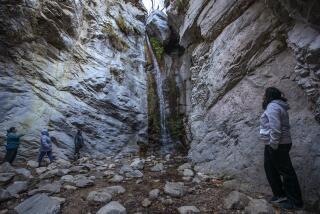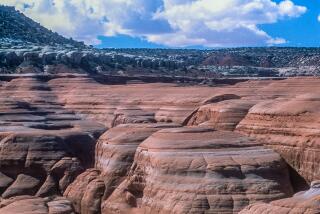North Dakota oil boom brings worry to Theodore Roosevelt National Park
WASHINGTON — On a stretch of ranchland nestled in the North Dakota Badlands, under dark, star-filled night skies, serene landscape and solitude, Theodore Roosevelt formed his strong conservationist ideals more than a century ago.
But the night skies around the former president’s Elkhorn Ranch, referred to as the “cradle of conservation” by environmentalists and historians, now glow orange. From some of the highest points in what is now Theodore Roosevelt National Park, dozens of natural gas flares are visible not far away. They’re the product of an oil boom using hydraulic fracturing, or fracking.
Interior Secretary Sally Jewell, in a speech Thursday outlining the administration’s conservation goals, cited Theodore Roosevelt National Park as an example of what some see as the quintessential issue for the department: striking the right balance between development and conservation.
“The purpose of the park is to provide for future generations,” said Winthrop Roosevelt, a great-great-grandson of the late president. The ability to do so is compromised, he said, if developers expose the parks to that type of drilling “without having a really good knowledge of the long-term effects it may have.”
Animals that live in the sparsely populated Badlands are seeing their habitat threatened, conservationists say. In addition to oil and light pollution, critics say, as many as 1,000 trucks a day kick up heavy dust on dirt roads made for light residential and tourist traffic. Winthrop Roosevelt and other descendants of the 26th president are concerned about these effects trickling farther into the park, of which the ranch is a small but important part, while drilling bumps up against its borders.
But keeping such development away from the park is complicated by the oil boom that is driving the economy of North Dakota.
“No one is saying, ‘We’re against the oil boom,’” said Jim Fuglie, a former North Dakota tourism director who writes about Badlands issues. “This is a huge economic benefit to North Dakota. But with a boom comes all kinds of problems.”
“We have pristine air, we have pristine water; nothing has ever threatened those things before,” Fuglie added. “We have cattle ranchers whose grass is being covered by the dust of a thousand trucks a day.”
Jewell said in her speech that the park’s superintendent, Valerie Naylor, described helping developers recognize their effect on the park “as something like playing Whac-A-Mole.” Jewell said that just as Naylor thought she had one area protected — a company had agreed to move a project farther away — “she had someone else over here.”
“She said, ‘I live in fear of taking a few days off.’”
Conservation groups and officials have noted that some leaseholders have been mindful of the park, listening to concerns before developing. But other proposals have been met with backlash from environmentalists and the Park Service: a bridge over the Little Missouri River, a gravel mine, and an oil well proposed by ExxonMobil subsidiary XTO Energy to drill within 300 feet of the ranch site.
Suann Lundsberg, a spokeswoman with XTO, said the company came up with another plan to drill out of sight of the ranch that would cost more money. “That allows us to develop the resources and reduce disturbances,” Lundsberg said, “and reduce our footprint.”
The land immediately surrounding the three sections of the 70,000-acre park — north and south units about 50 miles apart, with the ranch in between — belongs to private owners as well as the government, about half and half. The Interior Department said that most of the land surrounding the park, both public and private, is open for mineral development.
“The park has become an island in the sea of development” of the underground Bakken rock formation, Fuglie said.
Winthrop Roosevelt and other family members want a buffer zone around the park to mitigate the effects of development on the land where President Roosevelt developed his conservation ethic. One way to do that would be for President Obama to designate a national monument on the government land near the park. But getting Obama to do so is something of a long shot.
Ross Lane, the director of the Western Values Project, a conservation group, said Jewell’s comments Thursday echoed the sentiments of a lot of Westerners.
“There’s certainly a place for oil and gas development in North Dakota; it’s certainly part of the economic portfolio,” Lane said, “but we also need to look out for future generations.”
Jewell said Obama was ready to act to protect public lands, but she called on Congress to take the lead.
“This landscape, which inspired President Roosevelt and still inspires visitors today, is a big economic engine for the region,” Jewell said during her visit to the park in August. “It’s also a powerful reminder that, even as we bear witness to a production boom in the Bakken, there are places important to America that are too special to drill and must be protected for future generations.”
More to Read
Start your day right
Sign up for Essential California for news, features and recommendations from the L.A. Times and beyond in your inbox six days a week.
You may occasionally receive promotional content from the Los Angeles Times.






